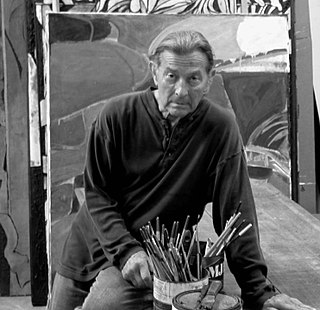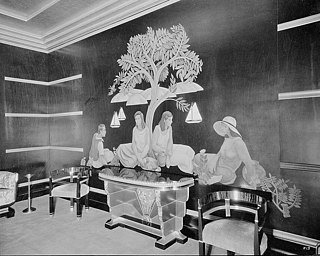Style
Carroll was known for his romantic portraits of women [8] [2] His major influences included Paul Cézanne, George Bellows, and Andrew Dasburg. [2]
![Carroll, John Wesley (c. 1940) Leda and the Swan [Mixed media on board] Leda and the Swan.jpg](http://upload.wikimedia.org/wikipedia/commons/thumb/9/97/Leda_and_the_Swan.jpg/220px-Leda_and_the_Swan.jpg)
John Wesley Carroll (Wichita, Kansas 1892 - Albany, New York Nov. 7, 1959) [1] was an American painter known for his modernist portraits.
John Carroll was born in Wichita, Kansas and grew up in San Francisco, California. [2] He studied art at the University of California, Berkeley and was awarded a Guggenheim Fellowship in 1927, [3] which allowed him to travel and work in Europe. He taught at the Art Students League in New York City before being chosen in 1930 to lead the painting department at the Society of Arts and Crafts in Detroit, where he taught for more than a decade. [4] A portrait he did of Gloria Vanderbilt and one of her children won the 1954 Benjamin Altman Prize from the National Academy of Design. Among several others, his work has been exhibited at the New York Museum of Modern Art, [5] the Whitney Museum, and the Detroit Institute of Arts. [6] He divided his time between his studio in New York City and his farm in East Chatham, New York where he raised cattle for the war effort. [7] Carroll died in Albany, NY in 1959. [1]
Carroll was known for his romantic portraits of women [8] [2] His major influences included Paul Cézanne, George Bellows, and Andrew Dasburg. [2]
![Carroll, John Wesley (c. 1940) Leda and the Swan [Mixed media on board] Leda and the Swan.jpg](http://upload.wikimedia.org/wikipedia/commons/thumb/9/97/Leda_and_the_Swan.jpg/220px-Leda_and_the_Swan.jpg)

Julius LeBlanc Stewart, was an American artist who spent his career in Paris. A contemporary of fellow expatriate painter John Singer Sargent, Stewart was nicknamed "the Parisian from Philadelphia".

John Wesley was an American painter, known for idiosyncratic figurative works of eros and humor, rendered in a precise, hard-edged, deadpan style. Wesley's art largely remained true to artistic premises that he established in the 1960s: a comic-strip style of flat shapes, delicate black outline, a limited matte palette of saturated colors, and elegant, pared-down compositions. His characteristic subjects included cavorting nymphs, nudes, infants and animals, pastoral and historical scenes, and 1950s comic strip characters in humorously blasphemous, ambiguous scenarios of forbidden desire, rage or despair.
David Salle is a Pictures Generation American painter, printmaker, photographer, and stage designer. Salle was born in Norman, Oklahoma, and lives and works in East Hampton, New York. He earned a BFA and MFA from the California Institute of the Arts, Valencia, California, where he studied with John Baldessari. Salle’s work first came to public attention in New York City in the early 1980s.

Henry Wessel was an American photographer and educator. He made "obdurately spare and often wry black-and-white pictures of vernacular scenes in the American West".
Karl Zerbe was a German-born American painter and educator.

Emerson Seville Woelffer was an American artist and arts educator. He was known as a prominent abstract expressionist artist and painter and taught art at some of the most prestigious colleges and universities. Woelffer was one of the important people in bringing modernism to Los Angeles, when he taught at Chouinard Art Institute.

James Jarvaise was an American painter based in Southern California.

Rico (Federico) Lebrun was an Italian-American painter and sculptor.

Francis de Erdely was a Hungarian-American artist who was renowned in Europe and the United States for his powerful figure paintings and drawings as well as for his teaching abilities.

Arnold Blanch, was born and raised in Mantorville, Minnesota. He was an American modernist painter, etcher, illustrator, lithographer, muralist, printmaker and art teacher.
James Welling is an American artist, photographer and educator living in New York City. He attended Carnegie-Mellon University where he studied drawing with Gandy Brodie and at the University of Pittsburgh where he took modern dance classes. Welling transferred to the California Institute of the Arts in Valencia, California in 1971 and received a B.F.A. and an M.F.A. in the School of Art. At Cal Arts, he studied with John Baldessari, Wolfgang Stoerchle and Jack Goldstein.
Larry Sultan was an American photographer from the San Fernando Valley in California. He taught at the San Francisco Art Institute from 1978 to 1988 and at the California College of the Arts in San Francisco 1989 to 2009.

John Paul Thomas was an American artist specializing in oil painting, watercolor and drawing in several media. He was also an educator and arts scholar.
Michael C. McMillen is a sculptor, installation artist, and short filmmaker from Los Angeles, California.

Charles Stafford Duncan (1892–1952) was a San Francisco painter and lithographer perhaps best known for his mural in the Paramount Theatre in Oakland, California. He won the Benjamin Altman Prize from the National Academy of Design in 1937.

Walter Sanford, also known as Sanford,, was an American artist who worked in a range of styles and influences using traditional media such as paint, ink, crayon and pencil. His artworks include collages, cartoons, pencil drawings, linoleum-cuts, woodcuts, sculptures, paintings, and portraits. He was one of the first and only black social realism and abstract expressionist artists of the 20th century. He was heralded "Black Picasso" and "Detroit's Picasso" for his cubist figure paintings and in 1958 he won the Prix de Paris La Grande Saison de Paris at the Raymond Duncan Galleries. In Detroit, he opened the first black-owned art gallery and exhibited at the first Negro Art Exhibition and Negro History Week and was hailed as one of Michigan's foremost modern art painters in 1952.
John Millard Ferren was an American artist and educator. He was active from 1920 until 1970 in San Francisco, Paris and New York City.
Sidney Gross was an American artist and painter. His early style was influenced by the Social realism. He also drew on the Surrealist Movement that was just beginning the year he was born. By the time he was twenty, he was painting distinctively urban surrealism, while producing critically admired portraits, something he continued to do during his lifetime.
Sidney Goodman was an American figurative painter and draftsman from Philadelphia, PA who explored the human form. Goodman received public notice in the early 1960s for his oil paintings, leading to his inclusion in the 1973 Whitney Biennial. In 1996, the Philadelphia Museum of Art presented a retrospective show of Goodman's paintings and drawings.
Malcolm Haynie Myers was an American painter, printmaker and professor known primarily for his Intaglio-style engravings. His work is included in numerous museum collections.
{{cite web}}: Missing or empty |title= (help)